
Solar Cooking: Rays of Transformation
Ruth Saavedra de Whitfield is a Bolivian social entrepreneur in Cochabamba with deep concern for the hard lives of her compatriots. In the spirit of Wangari Maathai, she helps them help themselves. Ruth’s infectious enthusiasm for her products and her boundless energy have had an impact beyond her community and now beyond Bolivia. She is a lead trainer in a World Bank sponsored initiative in Mexico.
Ruth sells the means of liberation from drudgery; protection from bodily harm; financial savings; pasteurized water; a better quality of life.
Ruth sells solar ovens.
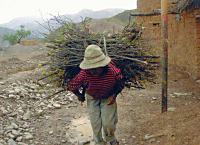
Gathering firewood in a region that now has none to spare
With her husband, David, who directs the Bolivian NGO Centro de Desarrollo en Energie Solar. she has been going from village to village over the last several years to demonstrate solar cooking. Those interested are offered materials and instruction to build an oven of their own, then training in how to use it. It takes David and Ruth a week in each community to do the job.
Some people can afford to pay the cost of the oven on time. Others are offered a barter contract in which they agree to build more ovens for the community or to train neighbors how to use them. Women can be transformed by learning to solar cook. Of one of her students, Ruth says: “Previously, Carmen had no self-esteem. Learning to solar cook gave her new confidence in herself. She is now my best trainer.”
In 2000, the mayor of Cochabamba wrote to support David’s competition in the International Tech Awards Program: “Clearly this technology has improved the lives of low income people in our area. . . . Requests for these cookers are greater than the current supply can meet.”
“Solar ovens?” you say, “do those things really work?”
Not only do they work, they can protect women and children from the pandemic of respiratory disease caused by inhalation of smoke from wood fires. They can free women from the punishing work of foraging for fuel wood and from the hours spent tending the cooking fire. They can reduce the degradation of the environment caused by unsustainable foraging and by the carbon dioxide released as fuel wood burns.
In 1995, Hubert-Paul Normil, director of the Solar Energy Program at the Free Methodist Church Mission near Port-au-Prince, Haiti, surveyed women he had trained to solar cook about their actual use of their solar ovens.
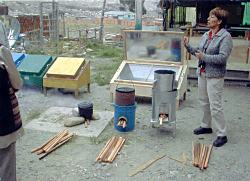
In a Bolivian altiplano community, Ruth Saavedra de Whitfield, describes the fuel efficiency of different cooking methods: the energy efficient, traditional three-stone fire and two fuel-efficient stoves that use 50 percent less firewood; in back are state-of-the-art solar ovens: the ULOG box oven and the SK paraboloid from EG-Solar.
In a representative interview with Mme. Joseph Valmon of Dubreuil (Commune de Torbeck), Cayes, told Hubert that, in the two years since she acquired her solar oven, she used it whenever the sun shined because the fuel was free. She bought charcoal for use on cloudy days. Mme. Valmon said she cooked everything — beans, rice, meat — for a family of eight.
“Sometimes I cook twice a day,” she said. “I start at 9 o’clock and around 10 the pot gets hot enough to cook. At 11 a.m. it’s cooked and I can start something else in it. The food tastes very good. I’m happy with it.”
Less well known than the crisis in Haiti are similar conditions throughout Latin America. The cost of cooking fuel is a serious drain on budgets. For example, a researcher from Queen’s University, Kingston, Canada, wrote from the Bolivian Altiplano in 2002, “many communities . . . are in dire need of a new source of energy for cooking … firewood [is] virtually exhausted.” The unsustainable use of firewood had denuded the land.
Pedro Serrano, an ASHOKA Fellow and environmental activist from Santiago, Chile reported in 2001 that “planners estimate there are 300,000 potential users of solar ovens in northern Chile. . . One person in every family dedicates all day, every day, to search for firewood.” A 2001 study by the Earth Council of Costa Rica estimated that we are burning “about one third more of the earth’s biological productivity than can be regenerated.”
At present, El Salvador has some of the most threatened ecosystems on the planet.
Nevertheless, there are relatively few who will change their traditional ways of life until they must. For growing hundreds of millions of people, that day is here or is imminent. When the wood is gone and petroleum products are unaffordable, unavailable, or both, what are the alternatives? In some places dung is used. The smoke is three times more toxic than that from wood. Or crop wastes can serve where they exist. Both would otherwise be valuable fertilizers. There are no other alternatives.
The attached map depicts areas of the Americas where solar ovens are viable.
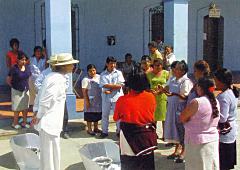
In the Oaxacan town of San Andres Huayapan, coauthor Louise Meyer, at left, fields questions about the Mexican-made HotPot.
There will, of course, be days of inclement weather when a back-up means of cooking is required. A combination of solar ovens, fuel efficient stoves and retained heat cookers is most desirable. However, solar ovens can be the primary means of cooking. For example, Ruth Whitfield and her husband David report 86 percent usage in some communities. Some areas enjoy over three hundred days of sun a year.
The growing awareness in the Americas of the compelling need for solar cooking is evident. There have been initiatives to introduce it in at least twenty-one countries including Mexico, Nicaragua, Peru and Paraguay. The scale of these efforts has varied, but all have been too modest.
A major impediment to solar development is absence of capital. Having worked so long on a shoestring, Ruth and David can attest to that. (A couple of years ago they were obliged to discontinue their phone service to pay the rent.) Thus, almost all solar ovens are the product of artisans or of individual manufacture. Production is far short of meeting the demands even of the few who know the technology exists.
Only a fraction of that third of humanity needing solar ovens has ever heard of them. The means have not been available to publicize solar cooking on the massive scale required. There can be little demand without awareness.
People have cooked with wood since the domestication of fire. Cultural resistance to change of so basic a tradition has been strong. However, many are confronted with a painful reality: there is nothing left to burn!
Countless solar ovens have been on the market for decades. Most are expensive, customarily around $100 or more. Cheap ones have been made for refugee camps at a cost of as little as $8 or so. Although remarkably effective, they tended to be fragile and had little commercial appeal.
There was evident need of a new solar oven that addressed these problems. Not only did it have to be inexpensive for those in greatest need (known as “preferred customers,”) it had to be durable. And efficient. And portable. And easy to use. And alluring. Without such a breakthrough, popular acceptance would continue to languish.
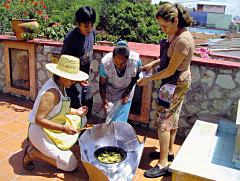
On a sunny, tiled veranda, Ruth Saavedra de Whitfield demonstrates cooking with the HotPot to a Mexican family. Solar cooking requires no stirring, only an adjustment to the path of the sun every hour or so.
Six years ago, Solar Household Energy, Inc., (SHE, Inc.) a U.S. nonprofit organization, addressed this challenge. Funding was acquired to retain leading solar energy scientists and engineers for the research and development. Various prototypes were designed and underwent multiple tests by solar-cooking experts on five continents and technical evaluation by numerous scientists and engineers. The result is a new, high-tech, low-cost solar oven called “HotPot.” It can meet a need of countless millions. SHE, Inc. has recruited expert solar cooks to train indigenous solar cooking instructors wherever the HotPot is sold. These experts are called Sunflowers (gira sol).
While the HotPot is still in its infancy, it has already proven to be commercially viable. There is demand wherever it is introduced. But how does it get into the hands of the millions who need it urgently? Those who exist at the edge of possibility, who actually burn a significant portion of their meager assets just to be able to cook from day to day?
At the global level the task of distribution is enormous. It would overwhelm the capacity of all the world’s philanthropies, private, public and international put together. They have tried temporary local programs in the past and had some enduring impact, but the means have not been there for them to do more.
On the other hand, private entrepreneurs distributing solar ovens for profit have strong incentives to persevere. But how can they succeed selling a product to customers with inadequate resources? That’s a dilemma requiring creative solutions.
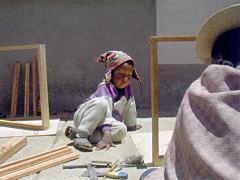
A Bolivian child looks on as measurements are taken for the construction of an inexpensive, box-shaped solar oven.
In many places, members of local women’s groups contrive to support each other in efforts to improve quality of life. Some groups have pooled their money to buy one or two ovens to share. In some places stores offer easy installment paying schemes. Elsewhere, customers with urgent need for a solar oven have offered to make installments until it’s paid in full before taking it home.
In some such cases where there is no disposable income, barter deals can work. For example, several years ago at the Dadaab refugee camp in eastern Kenya, women earned solar ovens by planting and nurturing trees.
Whatever funding is required to insure the success of private enterprise in the sale of HotPots is more than offset by the social, environmental, health, and economic impacts solar cooking promises. The cost-benefit ratio is great. For example, solar ovens address six of the eight United Nations Millennium Development Goals:
- Eradicate extreme poverty and hunger—by reducing the need to buy traditional fuels
- Improve maternal health—by permitting women to avoid respiratory disease and eye infection caused by toxic smoke.
- Achieve universal primary education—by reducing the school time children must spend helping their mothers forage for fuel wood.
- Promote gender equality and empower women—by liberating women from the onerous task of foraging for fuel wood, enabling them time to pursue profitable or educational endeavors.
- Ensure environmental sustainability— by reducing the destruction of trees for fuel wood.
- Reduce child mortality— by minimizing the danger of children falling into fires; by enabling the pasteurization of water.
CONCLUSION
Environmental degradation and war are depriving populations of their traditional household fuels.
Solar cooking is the most humane alternative for millions of women cooking with fire and suffering the punishing consequences.
A high tech solar oven that combines durability and low cost with high performance is now available. It is being distributed to the greatest extent possible by private social entrepreneurs. By dedicated people like Ruth. She tells everybody who will listen: “The best single way women can improve the well-being of the Bolivian family is to adopt solar cooking.”
HotPot sidebar
With a volume of five liters, the HotPot cooks all foods with only the sun’s free energy. The concept is elegant: A black steel pot is suspended by its flange inside a transparent tempered glass bowl with a half inch of air space between the two. The pot has a tight-fitting transparent tempered glass lid.
Surrounding the pot is a reflector. It is collapsible for easy carrying and storage. Direct and indirect solar energy penetrates the transparent glass, strikes the pot and converts to heat. The heat is retained around the pot by the glass bowl, achieving cooking temperatures.
Unlike cooking over fire which requires frequent stirring to keep food from burning, solar ovens need only an adjustment to the path of the sun each hour or so. Solar cooking time can be twice as long as traditional methods. This is offset by freedom from the need to forage for fuel or the cost of purchasing it. Little or no water is necessary for solar cooking, which renders food more savory and nourishing.
On the initiative of Lorenzo Rosenzweig, managing director of FONDO MEXICANO PARA LA CONSERVACION DE LA NATURALEZA, (FMCN), the HotPot is now mass produced by a factory in Monterrey, Mexico, at a cost of $24. A choice of two reflectors is available, a durable cardboard one for $4 and a deluxe aluminum model for $24.50.
Sr. Rosenzweig is now guiding the introduction of solar cooking in the network of biosphere reserves around Mexico. Through the Pan American Association of Conservation Organizations (REDLac), which he headed until this year, he introduced the HotPot to colleagues from all over Latin America.
* * * * * * * * * * * * * * * * * *
Dar Curtis has lived in Asia and Africa and traveled in Latin America where he witnessed the hardships imposed by traditional household fuels. Subsequently, he became a champion of solar cooking as a tool of social development and environmental protection. In 1991 he published a watershed global analysis of the potential of solar cooking. In it, he advocated market mechanisms for dissemination of solar ovens rather than earlier “welfare” models. Since then, he has guided R&D culminating in the mass production of the HotPot, a durable, efficient and inexpensive solar oven offering an urgently needed alternative to diminishing traditional fuels.



